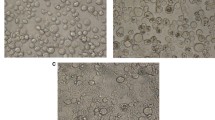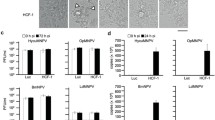Abstract
In this study, we describe a cell line, Ms-10C, cloned from the line QAU-Ms-E-10 (simplified Ms-10), an embryonic line from Mythimna separata. The cloned cell line was significantly more sensitive to nucleopolyhedrovirus (NPV). Ms-10C cells were mainly spherical with a diameter of 14.42 ± 2.23 μm. DNA amplification fingerprinting (DAF) confirmed the profile of PCR-amplified bands of the cloned cell line was consistent with those of the parental cell line, Ms-10. The sequencing result of the mitochondrial cytochrome c oxidase I (mtCO I) fragment confirmed that the amplified 636-bps mtCOI fragment was 100% identical to that of M. separata. Its chromosomes exhibited the typical characters of lepidopteran cell lines. Its population doubling time was 42.2 h at 27°C. Ms-10C was more sensitive than Ms-10 to both Autographa californica multiple nucleopolyhedrovirus (AcMNPV) and M. separata nucleopolyhedrovirus (MsNPV). At 4 d post infection, the infection rates of two viruses reached 94.2 and 92.3%, respectively. The availability of this cell clone strain will provide a useful tool for the basic research on nucleopolyhedrovirus and for potential application in expression of recombinant proteins with baculovirus expression vector system.



Similar content being viewed by others
References
Chakraborty M, Narayanan K, Sivaprakash MK (2004) In vivo enhancement of nucleopolyhedrovirus of oriental armyworm, Mythimna separata using spindles from Helicoverpa armigera entomopoxvirus. Indian J Exp Biol 42:121–123
Folmer O, Black M, Hoeh W, Lutz R, Vrijenhoek R (1994) DNA primers for amplification of mitochondrial cytochrome coxidase subunit I from diverse metazoan invertebrates. Mol Mar Biol 3:294–299
Gaw ZY, Liu NT, Zia TU (1959) Tissue culture methods for cultivation of virus grasserie. Acta Virol 3:55–60
Grace TDC (1962) Establishment of four strains of cells from insect tissues grown in vitro. Nature 195:788–789
Granados RR, Li GX, Blissard GW (2007) Insect cell culture and biotechnology. Virol Sin 22:83–93
Granados RR, Li GX, Derksen ACG, Mckenna KA (1994) A new insect cell line from Trichoplusia ni (BTI-Tn-5B1-4) susceptible to Trichoplusia ni singly enveloped nuclear polyhedrosis virus. J Invertebr Pathol 64:260–266
Hara K, Funakoshi M, Kawarabata T (1995) A cloned cell line of Spodoptera exigua has a highly increased susceptibility to the Spodoptera exigua nuclear polyhedrosis virus. Can J Microbiol 4:1111–1116
Hara K, Funakoshi M, Tsuda K, Kawarabata T (1993) New Spodoptera 280 exigua cell lines susceptible to Spodoptera exigua nuclear polyhe- 281 drosis virus. In Vitro Cell Dev Bio 29A:904–907
Hayflick L (1973) Theory of population increase by subcultivation. In: Kruse PF, Patterson MK (eds) Tissue culture methods and application. Academic Press, New York, pp 222–223
Ikeda M, Hamajima R, Kobayashi M (2015) Baculoviruses: diversity, evolution and manipulation of insects. Entomol Sci 18:1–20
Jiang X, Zhang L, Yang H, Sappington TW, Cheng Y, Luo LZ (2016) Biocontrol of the oriental armyworm, Mythimna separata, by the tachinid fly Exorista civilis is synergized by Cry1Ab protoxin. Sci Rep 6:26873
Lenz CJ, McIntosh AH, Mazzacano C, Monderloh U (1991) Replication of Heliothis zea nuclear polyhedrosis virus in cloned cell lines. J Invertebr Pathol 57:227–233
Li GX, Yu HC, Song J, Li CY, Wang XY (1998) New cell line from embryos of Mythimna separata (Lepidoptera: Noctuidae). Entomol Sin 5:89–94
Lynn DE (2001) Novel techniques to establish new insect cell lines. In Vitro Cell Dev Biol Anim 37:319–321
Mclntosh AH, Grasela JJ, Matteri RL (1996) Identification of insect cell lines by DNA amplification fingerprinting (DAF). Insect Mol Biol 5:187–195
Meng MJ, Li TL, Li CY, Li GX (2008) A suspended cell line from Trichoplusia ni (Lepidoptera): characterization and expression of recombinant proteins. Insect Sci 15:423–428
Mitsuhashi J (2002) Cell cloning. In: Mitsuhashi J (ed) Invertebrate tissue culture methods. Springer-Verlag, Tokyo, pp 307–319
Smagghe G, Goodman CL, Stanley D (2009) Insect cell culture and applications to research and pest management. In Vitro Cell Dev Biol Anim 45:93–105
Su R, Zheng GL, Wan FH, Li CY (2016) Establishment and characterization of three embryonic cell lines of beet armyworm, Spodoptera exigua (Lepidoptera: Noctuidae). Cytotechnology 68:1223–1232
Summers MD, Smith GE (1987) A manual of methods for baculovirus vectors and insect cell culture procedures. Texas Agric Exp Station Bull 1:1555
Yu HC, Wang XY, Han LL, Li GX, Guo W (2000) Replication of MsNPV in a homologous cell line. Virol Sin 15:72–75
Zhang H, Zhang Y, Qin Q, Li X, Miao L, Wang Y, Qu L, Zhang A, Yang Q (2009) A cell strain cloned from Spodoptera exigua cell line (IOZCAS-Spex-II) highly susceptible to S. exigua nucleopolyhedrovirus infection. In Vitro Cell Dev Biol Anim 45:201–204
Acknowledgements
This study was supported by the State Key Laboratory of Integrated Management of Pest Insects and Rodents (Grant No. ChineseIPM1602), Key Research and Development Program in Shandong Province (2015GNC111003), and Wheat Industrial I & E Team of Qingdao Modern Agriculture Industrial Technology System (QDAIET-16-01-06).
Author information
Authors and Affiliations
Corresponding author
Additional information
Editor: Tetsuji Okamoto
Rights and permissions
About this article
Cite this article
Meng, XQ., Zheng, GL., Zhao, CD. et al. A cell clone strain from Mythimna separata (Lepidoptera: Noctuidae) highly susceptible to Autographa californica multiple nucleopolyhedrovirus (AcMNPV) and M. separata NPV (MsNPV). In Vitro Cell.Dev.Biol.-Animal 53, 646–650 (2017). https://doi.org/10.1007/s11626-017-0166-x
Received:
Accepted:
Published:
Issue Date:
DOI: https://doi.org/10.1007/s11626-017-0166-x




